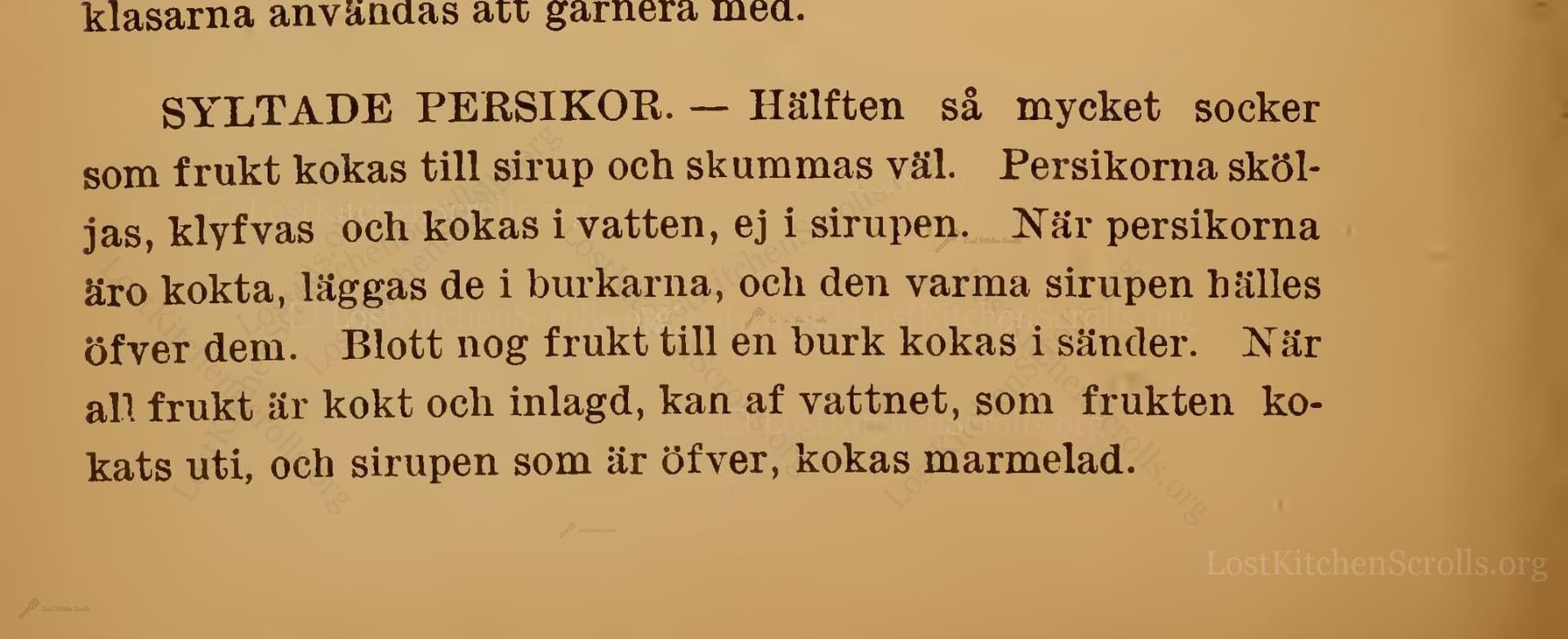Syltade Persikor
"Preserved Peaches"
From the treasured pages of Praktisk, illustrerad kok-bok för Svenskarne i Amerika
Written by C. A. (Charles A.) Vallentin

Syltade Persikor
"Hälften så mycket socker som frukt kokas till sirup och skummas väl. Persikorna sköljas, klyfvas och kokas i vatten, ej i sirupen. När persikorna äro kokta, läggas de i burkarna, och den varma sirupen hälles öfver dem. Blott nog frukt till en burk kokas i sänder. När all frukt är kokt och inlagd, kan af vattnet, som frukten kokats uti, och sirupen som är öfver, kokas marmelad."
English Translation
"PRESERVED PEACHES. — Half as much sugar as fruit is boiled to make syrup and skimmed well. The peaches are washed, halved, and boiled in water, not in the syrup. When the peaches are cooked, they are placed in jars, and the hot syrup is poured over them. Only enough fruit for one jar is cooked at a time. When all the fruit is cooked and stored, the water in which the fruit was boiled, together with any leftover syrup, can be used to make marmalade."
Note on the Original Text
The recipe is written in a succinct, practical style, common for its era—expecting a fair amount of prior kitchen knowledge from the reader. Units of measure are relative (proportions like 'half as much sugar as fruit') rather than absolute. Spelling reflects late 19th-century Swedish, with some formulations appearing quaint today ('öfver', 'sköljas', 'klyfvas'). The instructions are sequential but expect users to be familiar with basic techniques like skimming syrup and sterilizing jars.

Title
Praktisk, illustrerad kok-bok för Svenskarne i Amerika (1889)
You can also click the book image above to peruse the original tome
Writer
C. A. (Charles A.) Vallentin
Era
1889
Publisher
Svenska bok-och musikhandelns förlag
Background
A practical and charmingly illustrated Swedish cookbook tailored for immigrants in America, this 1889 volume serves up a delightful array of recipes and culinary wisdom, blending Old World tradition with New World ingredients.
Kindly made available by
Library of Congress
This recipe hails from 'Praktisk, illustrerad kok-bok för Svenskarne i Amerika', published in Minneapolis in 1889. The cookbook served as a culinary bridge for Swedish immigrants in the United States, helping them adapt cherished recipes to local American ingredients and conditions while maintaining their cultural heritage. Preserving fruit in syrup was a common way for immigrant households to ensure a taste of summer fruit through the colder months, especially in regions where fresh produce was seasonal and refrigeration limited.

In the late 19th century kitchen, cooks would have used a large enamel or copper pot for preparing the syrup and boiling the fruit, wooden spoons for stirring, and a skimmer to remove foam. Mason jars (or earlier glass jars with wax seals) were used for storage, and a kettle or large stockpot for sterilizing the jars. Knives for splitting and pitting the fruit, and possibly a ladle for transferring the hot syrup, would round out the necessary toolkit.
Prep Time
30 mins
Cook Time
30 mins
Servings
6
We've done our best to adapt this historical recipe for modern kitchens, but some details may still need refinement. We warmly welcome feedback from fellow cooks and culinary historians — your insights support the entire community!
Ingredients
- 2.2 lbs fresh peaches (or nectarines as substitute)
- 1.1 lbs granulated sugar (white, or light brown if preferred)
- Water (enough to cook fruit and create syrup)
Instructions
- To make these delightful preserved peaches, start by preparing a simple syrup: use half as much sugar as you have fruit, by weight.
- For example, if you have 2.2 pounds of peaches, take 1.1 pounds of granulated sugar.
- Combine the sugar with enough water to dissolve it, bring to a gentle boil, and skim off any foam that rises to the top.
- Meanwhile, wash and halve your peaches (about 2.2 lbs), removing the pits.
- In a separate large pot, bring water to a boil and carefully simmer the peach halves until just tender—do not add them to the syrup at this stage.
- Once the peaches are cooked, gently transfer them into sterilized glass jars, filling each jar as you go.
- Pour the hot syrup over the peaches in the jars to cover them completely.
- Only cook enough fruit for one jar at a time for best texture and flavor.
- If you have cooking liquid left from simmering the peaches and any extra syrup, combine them and reduce over heat to make a simple peach marmalade.
Estimated Calories
150 per serving
Cooking Estimates
You will spend a bit of time preparing the peaches, boiling water, simmering the fruit, and making the syrup. The whole process takes about an hour. Each serving of these preserved peaches contains around 150 calories. This recipe makes about 6 servings.
As noted above, we have made our best effort to translate and adapt this historical recipe for modern kitchens, taking into account ingredients nowadays, cooking techniques, measurements, and so on. However, historical recipes often contain assumptions that require interpretation.
We'd love for anyone to help improve these adaptations. Community contributions are highly welcome. If you have suggestions, corrections, or cooking tips based on your experience with this recipe, please share them below.
Join the Discussion
Rate This Recipe
Dietary Preference
Main Ingredients
Culinary Technique

Den Bockfisch In Einer Fleisch Suppen Zu Kochen
This recipe hails from a German manuscript cookbook compiled in 1696, a time whe...

Die Grieß Nudlen Zumachen
This recipe comes from a rather mysterious manuscript cookbook, penned anonymous...

Ein Boudain
This recipe comes from an anonymous German-language manuscript cookbook from 169...

Ein Gesaltzen Citroni
This recipe, dating from 1696, comes from an extensive anonymous German cookbook...
Browse our complete collection of time-honored recipes



